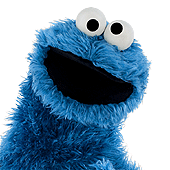Oh, the signs in the new clip are real (as some Seattle natives have confirmed when it was up before).
The signs are real? Weird. It just looks so Photoshopped.
If the Workshop has to include an
animated character in a wheelchair to show that disabled people are active and have the same feelings as everybody else--it's probably because they thought the audience would react badly to a
real boy in a wheelchair. (That, plus they might not want to deal with medical problems on the set...

) The way Sesame Street is evolving nowadays, real people always seem to play second fiddle to Muppets and animated characters; what happened to the original idea of having humans and Muppets/animations appearing together?
Again, it's this "Newer is always better--especially with computer animation" attitude nowadays. Also, there's so much animated stuff for kids out there now, Sesame Street has to compete with the Dora the Explorer/Blues Clues-fare that's out there.
Putting "hey cow" aside, I enjoyed the "real world" clips as much as the Muppet/street segments. Why? Well, for the simple reason Sesame Street exists (according to Rowlf and Kermit): "Hey kids, there's lots of neat stuff out there in this big, wide world and we'll show it to you, bit by bit. Oh, and by the way, it's brought to you today by the letter E and L and the number 4."
These clips (like the original Me and My Chair, etc.) taught me a lot about the real world. There I was, a little kid in the Midwest surrounded by cornfields and livestock. Even the town I grew up in wasn't diverse (ethnically anyway). It was one of those towns where the old, Caucasian farmers went to retire. Statler, Waldorf & Astoria times 5,000. As for handicapped kids, our schools just had "special classes" for them. There was no integration fpr them back then, so we never saw them. Even in my elementary school, there wasn't much on other cultures/people aside from "Social Studies". Even that was 95% American history with heavy emphasis on "George Washington chopped down the cherry tree"-type stuff.

I always wondered about what went on in other countries we barely mentioned in school. "South America exports coffee and bananas...Australia is the smallest continent."
But what about the people and animals that live there? What's the rest of the world like away from this endless sea of cornfields I'm in? Huh?
Sesame Street gave me my first answers to those questions AND showed me all this other stuff I might have missed. The real world stuff on Sesame Street was where I learned about real world diversity, in human, animal and geographical forms. I loved the idea of someone taking a camera and filming someone or something new in such a positive light, then transmitting it to me at home. It was even more awesome to me when one of the familiar Sesame Street humans was there. Along with the Hawaii/New Mexico/Puerto Rico episodes, this clip was one of my favorites out of the "real world" bits:
http://www.youtube.com/watch?v=U0IeSzG8eBo
Back on the subject, DrTooth has a point with the "court order bussing" when introducing a human handicapped member to the cast. I remember who you meant...the little girl named
Tarah, right? If they try to introduce another handicapped person to the cast, why don't they look at the episode Linda was
introduced and work from there? Obviously they succeeded with her. Linda was on the street for ages and they didn't make a BIG deal about her being deaf. She just
was and hung out with everyone else.
I also never got the Larry and Phyllis bits. Must've been more for the adults (as a comedy team thing) than for the kids. When I taped the episodes on Noggin, I just fast forwarded through 'em to get to the better clips.
Also, here's something interesting. SW (then CTW) noticed how ineffective the Buddy and Jim, et al. bits were with kids. Bumbling actors messing up a simple task most kids knew how to do anyway just didn't work on the show. So they pitched 'em.
Now, if the "Buddy and Jim concept" was tossed and deemed ineffective, then why in the heck are
these guys around? Food for thought.
Convincing John

 Welcome to the Muppet Central Forum!
Welcome to the Muppet Central Forum!.jpg) Christmas Music
Christmas Music Macy's Thanksgiving Parade
Macy's Thanksgiving Parade Sesame Street debuts on Netflix
Sesame Street debuts on Netflix Back to the Rock Season 2
Back to the Rock Season 2 Sam and Friends Book
Sam and Friends Book Jim Henson Idea Man
Jim Henson Idea Man Bear arrives on Disney+
Bear arrives on Disney+ ) The way Sesame Street is evolving nowadays, real people always seem to play second fiddle to Muppets and animated characters; what happened to the original idea of having humans and Muppets/animations appearing together?
) The way Sesame Street is evolving nowadays, real people always seem to play second fiddle to Muppets and animated characters; what happened to the original idea of having humans and Muppets/animations appearing together?

 I always wondered about what went on in other countries we barely mentioned in school. "South America exports coffee and bananas...Australia is the smallest continent." But what about the people and animals that live there? What's the rest of the world like away from this endless sea of cornfields I'm in? Huh?
I always wondered about what went on in other countries we barely mentioned in school. "South America exports coffee and bananas...Australia is the smallest continent." But what about the people and animals that live there? What's the rest of the world like away from this endless sea of cornfields I'm in? Huh?